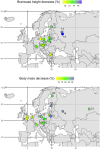Geographic patterns in seasonal changes of body mass, skull, and brain size of common shrews
- PMID: 33767812
- PMCID: PMC7981214
- DOI: 10.1002/ece3.7238
Geographic patterns in seasonal changes of body mass, skull, and brain size of common shrews
Abstract
Some small mammals exhibit Dehnel's Phenomenon, a drastic decrease in body mass, braincase, and brain size from summer to winter, followed by a regrowth in spring. This is accompanied by a re-organization of the brain and changes in other organs. The evolutionary link between these changes and seasonality remains unclear, although the intensity of change varies between locations as the phenomenon is thought to lead to energy savings during winter.Here we explored geographic variation of the intensity of Dehnel's Phenomenon in Sorex araneus. We compiled literature on seasonal changes in braincase size, brain, and body mass, supplemented by our own data from Poland, Germany, and Czech Republic.We analyzed the effect of geographic and climate variables on the intensity of change and patterns of brain re-organization.From summer to winter, the braincase height decreased by 13%, followed by 10% regrowth in spring. For body mass, the changes were -21%/+82%, respectively. Changes increased toward northeast. Several climate variables were correlated with these transformations, confirming a link of the intensity of the changes with environmental conditions. This relationship differed for the decrease versus regrowth, suggesting that they may have evolved under different selective pressures.We found no geographic trends explaining variability in the brain mass changes although they were similar (-21%/+10%) to those of the braincase size. Underlying patterns of change in brain organization in northeastern Poland were almost identical to the pattern observed in southern Germany. This indicates that local habitat characteristics may play a more important role in determining brain structure than broad scale geographic conditions.We discuss the techniques and criteria used for studying this phenomenon, as well as its potential presence in other taxa and the importance of distinguishing it from other kinds of seasonal variation.
Keywords: Dehnel's Phenomenon; Sorex araneus; brain mass; life‐stage cycling; phenotypic flexibility; seasonal plasticity.
© 2021 The Authors. Ecology and Evolution published by John Wiley & Sons Ltd.
Conflict of interest statement
The authors declare no conflict of interest.
Figures






References
-
- Apfelbach, V. R. , & Kruska, D. (1979). Zur postnatalen Hirnentwicklung beim Frettchen Mustela putorius f. furo (Mustelidae; Mammalia). Zeitschrift Für Säugetierkunde, 44, 127–131.
-
- Bergmann, C. (1848). Über die Verhältnisse der Wärmeökonomie der Thiere zu ihrer Grösse. Göttinger Studien, 3, 595–708.
-
- Bielak, T. , & Pucek, Z. (1960). Seasonal changes in the brain weight of the common shrew (Sorex araneus Linnaeus: 1758). Acta Theriologica, 13, 297–300.
-
- Brown, E. B. (1973). Changes in patterns of seasonal growth of Microtus pennsylvanicus . Ecology, 54, 1103–1110. 10.2307/1935576 - DOI
Publication types
Associated data
LinkOut - more resources
Full Text Sources
Other Literature Sources

